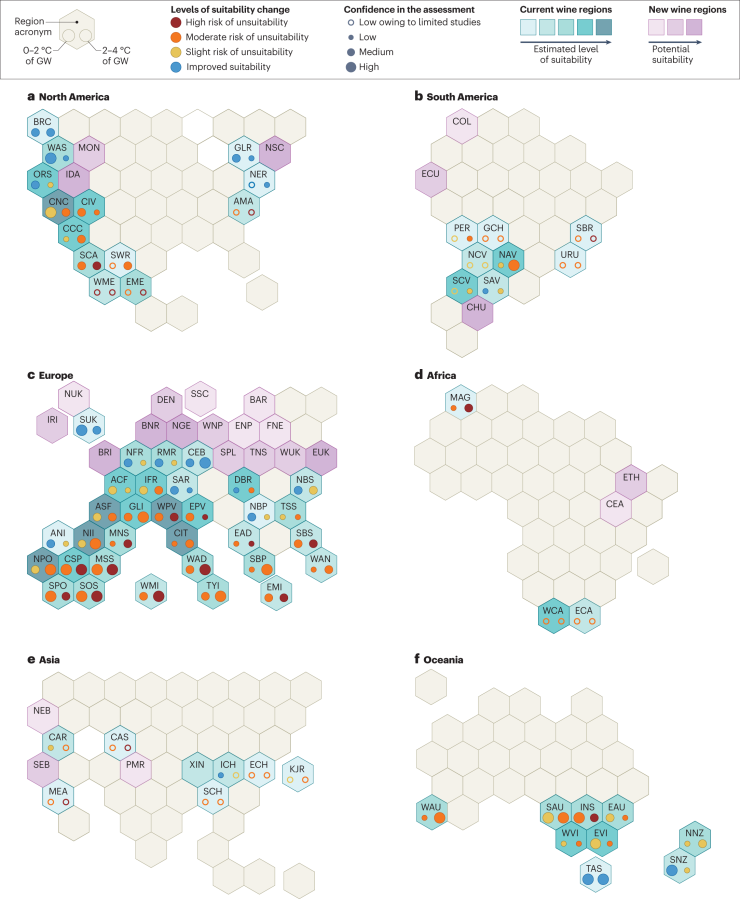A global map of how climate change is changing winegrowing regions
INRAE, Bordeaux Sciences Agro, CNRS, Université de Bordeaux and Université de Bourgogne have analysed trends to come in current and developing winegrowing regions around the world to adapt wine production to climate change.
The results of the study, published in Nature Reviews Earth and Environment, show that some 90% of coastal and low-altitude regions in southern Europe and California may no longer be able produce good wine in economically sustainable conditions by the end of the century if global warming exceeds +2°C. Other regions, however, could benefit: growing potential could increase in areas such as northern France and British Columbia (Canada), and rising temperatures could result in the development of new growing regions in countries as far as Denmark.
Grapes grown to make wine are sensitive to climate conditions such as temperature and extreme drought. These effects are already visible worldwide on yields, the composition of grapes and the quality of wines, with already and soon-to-be-observed consequences on the geography of wine production. Understanding shifts in wine production potential due to climate change is a major scientific concern. Based on their expertise and a thorough analysis of the scientific literature — over 250 publications in the last 20 years – a research team has established a global map of evolving trends in the threats and potential benefits that climate change brings to existing and new winegrowing regions. They did so by studying the effects of changes in temperature, rainfall, humidity, radiation and CO2 on wine production and exploring adaptation strategies.
Climate winners, climate losers
Winegrowing regions are primarily located at mid-latitudes where the climate is warm enough to allow grape ripening, but without excessive heat, and relatively dry to avoid strong fungal disease pressure. Rises in temperature – one of the most emblematic symptoms of climate change – accelerate vine development and the early ripening of grapes during the hottest periods in the summer. Harvesting in most vineyards now begins two to three weeks earlier than it did 40 years ago, with effects on grapes and the resulting styles of wines. Temperature increases, for example, can change how a wine tastes if grapes lose acidity, increase wine alcohol, and modify aromatic signatures. On a global scale, climate change could reduce growable surface area in current wine regions and increase it in others.
If global warming exceeds 2°C, some 90% of all traditional winegrowing areas in the coastal and plains regions of Spain, Italy, Greece and southern California may become unable to produce high-quality wine in economically sustainable conditions by the end of the century due to risks of excessive drought and more frequent heat waves. Conversely, higher temperatures could improve the suitability of other regions for the production of quality wines, including northern France, the states of Washington and Oregon in the United States, the province of British Columbia in Canada and Tasmania in Australia. They could even create new wine regions, in Belgium, Netherlands and Denmark.
The emergence of new diseases and pests, as well as an increase in the frequency of extreme events, are other upcoming challenges for producers. Vineyards can withstand global warming below the 2°C limit by using more drought-resistant grape varieties and rootstocks and by adopting management methods that better preserve soil water, such as decreasing vineyard density and protecting against erosion, as demonstrated by several studies conducted in partnership with winegrowers1. Adaptation strategies also depend heavily on local conditions and are only worthwhile if they can ensure the economic viability of production. Producers in higher latitudes, on the other hand, may see their yields and the quality of their wine increase thanks to rising temperatures.
This study confirms the heightened threat that climate change poses to the quality of wines produced in traditional vineyards. It also confirms the key 2°C limit beyond which global warming will make major changes necessary in wine production worldwide.

Global changes in winegrowing suitability at temperature increases of +2°C and +4°C. Van Leeuwen C. et al. (2024). © Climate change impacts and adaptations of wine production. Nature Reviews Earth and Environment.